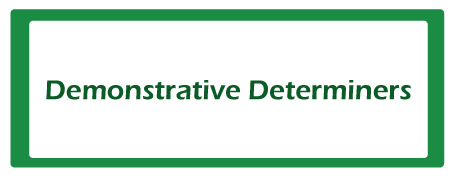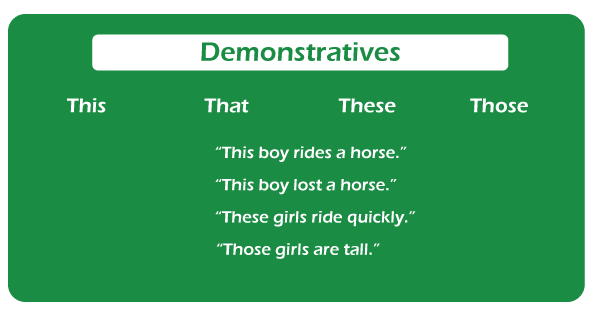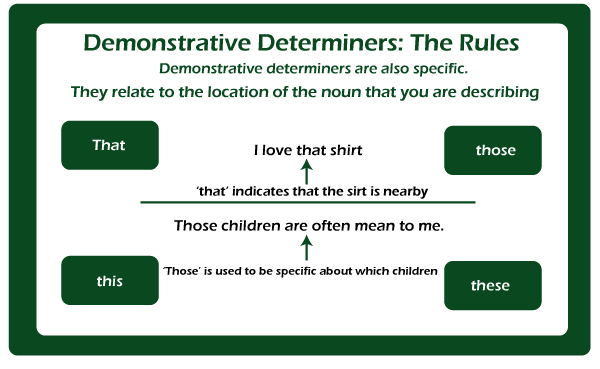Demonstrative DeterminersDemonstrative Determiners refer to an individual, location, item, or article and specify their physical or psychological proximity to the speaker. Demonstratives include: here, this, these, there, those, and that. 
Consider the following sentences as examples:
Here, this, these are demonstratives employed when the person speaking is close to them. They can, however, also be used to signify the present. Types of Demonstratives

1. The Determiner of Singular Proximal DemonstrativeThe very first demonstrative determiner is this. It is a singular proximal demonstrative determiner. Proximal implies "extremely close to." singular in number means that the antecedent pertains to only one individual, location, object, or idea. 2. Distal Singular Demonstrative DeterminerThe 2nd demonstrative determiner is that. It is the singular distal demonstrative determiner. Distal implies "far away or remote from." singular pertains to the singular in number once more. 3. The Determiner of Plural Proximal DemonstrativeThese, the plural proximal demonstrative determiner, is the third demonstrative determiner. The plural in number means that the antecedent pertains to two or more individuals, places, objects, or ideas. Again, proximal implies "extremely near or close to." 4. The Determiner of Plural Distal DemonstrativeThe 4th demonstrative determiner is those. It is the plural distal demonstrative. Plural pertains to the multitude in numbers, and distal denotes "remote or far from." 
ExamplesDemonstratives such as that, those which suggest a greater distance of subjects from the speaker can occasionally be employed to refer to the past. Examine the following example statements:
Demonstratives can come before a noun or an adjective. For example, this vehicle, that black range rover, these gleaming gems, and so on. When the word is understood from circumstances, demonstratives can also be utilized. As an example,
This and that are both singular, which means they only discuss one subject.
This, that, these, and those are the main demonstratives, indicating where items are and their quantity or how many of them are present. They all appear as preceding nouns in the instances above. Thus, they are determiners. However, these four terms might be used without nouns as pronouns. They are known as demonstrative pronouns in this circumstance.
When we hear these sentences, we can imagine someone referring to or gesturing toward the water, phones, and shoes. By emphasizing what they're referring to, the listener understands which nouns the pronouns are substituting. As a result, they can employ pronouns rather than having to speak the nouns. Determiners, "this," "that," "these," and "those": Which to Use
What Is the Distinction Between Demonstrative Determiners and Demonstrative Pronouns?While they are the same terms (this, that, these, and those), demonstrative determiners and demonstrative pronouns are used differently :
Compare: Is this stylus yours ? (demonstrative determiner) Is this your phone ? (demonstrative pronoun) These structures are extremely tall. (demonstrative determiner) These are extremely tall structures. (demonstrative pronoun) Note: Determiners indicate if a noun is general or specific. The presence of demonstrative determiners indicates that the noun or noun phrase is distinctive.You employ a particular determiner once you know that the individual who is reading your texts or hearing you understands what you are referring to. In other terms, you have a clear antecedent. SummaryIn English grammar, demonstrative determiners are literally and metaphorically proximity determiners, indicating whether the distance is real (spatial deixis, relating to actual space) or subjective discourse deixis, implying to emotional space comprising of space resulting in from time. The demonstrative determiner is a grammatical type and so serve a determinative grammatical role.
Next TopicDeterminers Rules
|
 For Videos Join Our Youtube Channel: Join Now
For Videos Join Our Youtube Channel: Join Now
Feedback
- Send your Feedback to [email protected]
Help Others, Please Share










